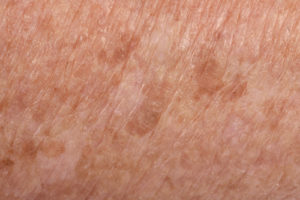Dark spots, also known as hyperpigmentation, appear on your skin when you produce more melanin than usual. Melanin gives your eyes, skin, and hair their color. They aren’t cause for medical concern and don’t need treatment. This article talks about dark spots and how to get rid of them.

Symptoms of Dark Spots
The color of dark spots can range from light to dark brown. It all depends on your skin tone. They feel the same as the rest of your skin and aren’t supposed to be painful. They can be different in sizes and be on any part of your body. The parts of your body that are exposed to the sun are the most likely areas to get spots.
You can get them on:
- The back of your hands
- Face
- Back
- Shoulders
7 Things that Cause Dark Spots
There are different reasons that dark spots can appear.
1. Sun Damage
Some people call dark spots sunspots because of being exposed to the sun or tanning beds. As mentioned before, the areas that are out in the sun are most likely to get sunspots.
2. Hormonal Changes
There is a skin condition called melasma that causes small patches of skin discoloration. It happens more to women, especially during pregnancy. This is because hormones trigger this condition.
3. Medication Side Effects
Some medication can create more skin pigmentation and create dark spots. Medicines that do this are non-steroidal anti-inflammatory drugs (NSAIDs), tetracyclines, and psychotropic drugs.
4. Inflammation
If you have skin inflammation often, it can cause dark spots. Skin inflammation can happen because of eczema, psoriasis, injury to the skin, and acne.
5. Wound Healing
Dark spots can stay after an insect bite, burn, or a cut heals. They can fade in time.
6. Irritation
Cosmetic skin or hair products can mess with your skin and make dark spots.
7. Diabetes
This condition can cause areas of the skin darker.
7 Ways to Get Rid of Dark Spots
If you feel more comfortable without dark spots, there are ways to get rid of them. You should choose the best treatment based on the cause, size, and the area the dark spot is on.
1. Laser Treatment
There are different types of laser treatments you can use. The most common is an intense pulse light laser. It targets melanin and breaks up the dark spots.
2. Microdermabrasion
This is a special treatment where a device that has an abrasive surface is used. It removes the outer layer of the skin and encourages new collagen growth, which can lighten dark spots.
3. Chemical Peels
This is when you put a mixture on your skin that exfoliates the surface, making new skin growth and fade dark spots.
4. Cryotherapy
This when liquid nitrogen is applied to the dark spots to freeze them. Freezing hurts skin cells, and the spots will lighten after healing.
5. Prescription Skin Lightening Cream
This bleaches your skin which is why you can only get it by prescription. It will take months to lighten the dark spots. Hydroquinone, an active ingredient in these creams, prevents skin from making melanin.
These products have a strength of 3 or 4%.
6. Over the Counter Creams
If you don’t have a prescription, you can look at over the counter creams. They won’t be as strong as prescription ones, but they work. They will have different ingredients like retinol or alpha hydroxy acid. These speed up the exfoliation and create more skin growth.
Pick ones that are recommended by dermatologists to avoid any potential harmful creams.
7. Natural Remedies
Certain natural ingredients can help treat dark spots. Look for niacinamide—a form of vitamin B-3, soy, licorice extracts, and mulberry. It’s not known for sure if these work, but according to researchers, they show great promise.
Treatments to Avoid
There are a lot of suggested treatments out there, but you have to be careful about which ones you pick. Remedies that involve lemon or apple cider vinegar have no evidence that they work. Some unproven treatments can irritate the skin and make dark spots worse.
Read more here.

